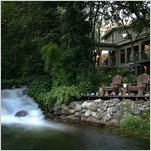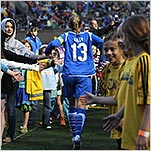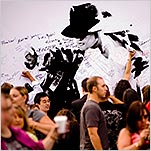The Revolutionary Guards, the Praetorian guard that has long protected the government of Iran, posted a notice on its Web site on Monday saying that further protests would not be tolerated.

Iranian riot police officers on motorcycles broke up traffic while on patrol in Tehran on Monday.
“The Guards will firmly confront in a revolutionary manner rioters and all those who violate the law,” the notice said.
Anyone attempting to identify divisions within the Iranian security forces that may dilute the government’s ability to stop the protests has thus far searched in vain, according to Iranian analysts and American government officials.
So far, the government has deployed the Revolutionary Guards, Basij vigilante squads and special riot police officers to confront demonstrators protesting the June 12 presidential election results. A rumor that at least one decorated commander of the Revolutionary Guards was arrested for refusing to suppress the demonstrations has been impossible to confirm.
Although outsiders may be cheering on the idea of people power, there is no sign yet that any part of the military will switch sides, analysts said, and the government retains plenty of reserve forces to quell protests.
“What matters is what happens around the commander table within the Revolutionary Guards, and we are not privy to that,” noted one United States-based scholar, speaking on the condition of anonymity because he researches in Iran. “We are not seeing any dissension, nothing in their press, nothing in their statements — and they have not publicly gone to visit Moussavi,” he said, referring to the opposition leader, Mir Hussein Moussavi.
The government can confront demonstrators with four layers of security forces, all of them answering to the supreme leader, Ayatollah Ali Khamenei. The first two rings are police officers and the Basij militia. The Basij, a paramilitary militia whose members have varying degrees of military training, is estimated to number about three million nationwide, although the government sometimes says the group has 11 million members.
The third layer — and probably the most resolute group — is the Revolutionary Guards, a force formed after the 1979 revolution because the fledgling government did not trust the military for protection. Although the shah’s military switched allegiances, sealing his fate, the mullahs wanted their own force.
Just 120,000 strong, the Revolutionary Guards have their own land, naval and air forces. In recent years, the Revolutionary Guards have turned into an economic juggernaut, becoming the largest receiver and subcontractor of government contracts, developing everything from the Pars natural gas fields to dams to the railroad network.
The fourth layer is the regular army, the Artesh. It is far larger than the Revolutionary Guards, with 430,000 people, but it is assigned to protect the borders and has no political role. Because its foot soldiers consist of conscripts who serve a mandatory military service of about two years, it is considered far less reliable to suppress domestic unrest.
The Revolutionary Guards are much more focused on indoctrinating their members with the idea that the revolution comes first. Plus, many commanders have moved on to take senior positions in the Intelligence and Interior ministries, and even in the regular armed forces. President Mahmoud Ahmadinejad himself was a midlevel commander in the Revolutionary Guards and, like many of them, views his sacrifices during the eight-year Iran-Iraq war as a mandate to run the country now.
“The Revolutionary Guards are a social and economic ladder,” said Afshon P. Ostovar, who is writing his doctoral thesis at the University of Michigan about the Iranian security forces.
In the face of repeated rumblings about a possible attack on Iran by either Israel or the United States, Ayatollah Khamenei replaced the commander of the Revolutionary Guards about 18 months ago. The new leader, Mohammad Ali Jafari, is a specialist in guerrilla warfare and insurgency tactics, Mr. Ostovar said. He has made the force less centralized, giving greater responsibility to the commanders in each of Iran’s 30 provinces. Most provincial governors are alumni of the Revolutionary Guards.
In addition, much of the Revolutionary Guards was combined with Basij forces in the same military bases or at least given joint training, Mr. Ostovar said. Before that, the Basij, including female units, had been used primarily as a kind of vice squad, looking for drug addicts, prostitutes and mostly women but also men wearing immodest dress.
That combination means that the military has rather intimate knowledge of the populations of cities and neighborhoods across Iran. “They organize in every office, every university, every mosque,” said Fatimah Haghighatjoo, a former reformist member of the Iranian Parliament who is now a visiting scholar at the University of Massachusetts in Boston. They have plenty of financial and technological resources, she said, given the support showered on them by Mr. Ahmadinejad.
“They know who the activists are, and they have opened cases against them everywhere,” said Ms. Haghighatjoo, who was put on trial for human rights activities before she left Iran.
The move to suppress the current protests is beginning to take shape, with the mass deployment of security forces, the scattering of demonstrators and the purging of the movement’s leadership, analysts said. “These will be concentrated military, paramilitary and intelligence operations,” said the Iran scholar in the United States. “They will figure out who are the ringleaders, who are the main thinkers.”
That strategy has proved effective in the past and is one reason that the government has not needed the Revolutionary Guards to roll their tanks onto the streets, analysts said.
When Mr. Moussavi, the opposition leader, harshly criticized the government on Sunday, he took great pains not to include the military. “In this road, we are not up against the Basij members; Basijis are our brothers,” part of his statement read. “In this road, we are not up against the Revolutionary Guards members; they are protectors of our Revolution and regime.”















